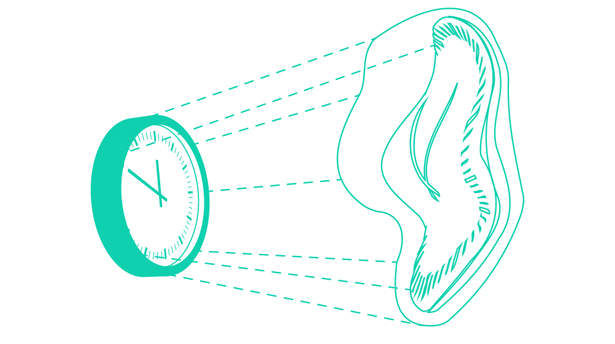Solution: ‘Hanging Far Out Over the Edge’
Our November Insights puzzle challenged you to stack identical flat objects, one per level, so that they project over the edge of a table as far as they will go. While there are more efficient ways to create overhang, as we will see later, the reason we chose this restriction is that the mathematics behind it is simple and elegant. Let’s take a look.
Question 1
The classic overhang problem stipulates that all the blocks must be homogeneous, identical in shape and size and have a length of one unit; there can be only one block at every level of the stack; and none of the blocks can be bound or glued or attached to one another in any way. If you had five such blocks, what is the maximum horizontal distance that the tip of the top block can be made to project past the edge of the table? Can you derive a formula for the maximum overhang possible for n blocks?
The physical principle here is to balance the torque (or moments) on the two sides of the table’s edge. The torque on each side is the product of the mass on that side and the distance from its center of mass to the edge. When the entire object’s center of mass is directly above an edge, both sides have equal torque, and the net torque about the edge is zero. For a composite object such as a stack of blocks, the total torque about any given edge can be found by adding together the torques of all its component parts. This allows us to divide and conquer the overhang problem in a simple way by considering only the changes that take place when we add a single new block to a preexisting stack, in a manner similar to mathematical induction (you can think of it as physical induction).
Consider a stack of n–1 blocks, each weighing one weight unit and with a length of one length unit, exactly balanced at the edge of a table. Imagine that your line of sight is exactly along the table’s edge, and the table is to your left so that the overhanging ends of the blocks extend to the right. Since the stack is exactly balanced, the center of mass is exactly over the edge, and the whole stack has a torque of zero there. Now imagine lifting this entire stack vertically and placing another block below it such that the right edge of this block is flush with the table’s edge. This might be a difficult thing to do in practice, but in a thought experiment, it’s a breeze (something you don’t want around real-life stacks).
We have added some extra stability to the stack by adding the nth block at the bottom, so the center of mass of the n-block stack will have shifted some distance to the left. Let’s call this distance x. The n blocks, weighing n units, now have a net torque of xn about the edge of the table toward the left. Recall that the top n–1 blocks have a net torque of zero. The only thing that has been added to cause this change is the torque of the new block — a mass of one times a distance of half a unit from the table’s edge.
Equating these, we get $latex xn = \frac{1}{2} $ which gives $latex x = \frac{1}{2n} $ where x is the distance to the new center of mass from the edge of the table.
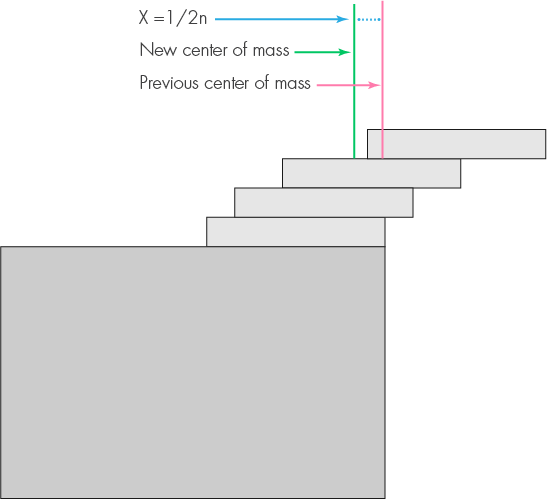
So for five blocks, we can plug in the n’s for each level from one to five to get the maximum overhang, which will be simply:
$latex x = \frac{1}{2}+\frac{1}{4}+\frac{1}{6}+\frac{1}{8}+\frac{1}{10}= \frac{137}{120}= 1.141\bar{6} $
You can see that starting from the top and adding blocks to the bottom, each term is one-half of the reciprocal of the number of blocks that have been stacked thus far. This kind of series, based on successive reciprocal numbers, is known as a harmonic series. As mentioned in the puzzle, this is a series that slowly diverges so that its sum rises toward infinity as n is increased without limit.
The general formula for the sum for n blocks is given by simply extending the series. This sum is one-half of the nth harmonic number, which can be mathematically written as:
$latex H_{n}= \sum_{k=1}^{n}\frac{1}{k} $
Question 2
Imagine that you have the same five blocks as before, and you want to balance a little ornament on the topmost overhanging block, at the point on its center line located a quarter of the block’s length away from the overhanging end. The blocks all weigh one unit and the ornament weighs one-fifth of a unit. What’s the maximum overhang possible now? How does this change the general formula for maximum overhang?
Let’s consider just the first block with the ornament on it, lying with its right edge flush with the table. The center of mass of the block without the ornament is half a unit from the table’s edge. This will be shifted to the right by the ornament, let us say by a distance of x units. The mass of the ornament is 1/5, and its distance from the new center of mass is 1/4 – x. Equating the moments, we have x = 1/5(1/4 – x), which gives x = 1/24 units. The ornament causes the first block to have to be pulled to the left by 1/24 units, so the maximum overhang is now 11/24 units instead of 1/2.
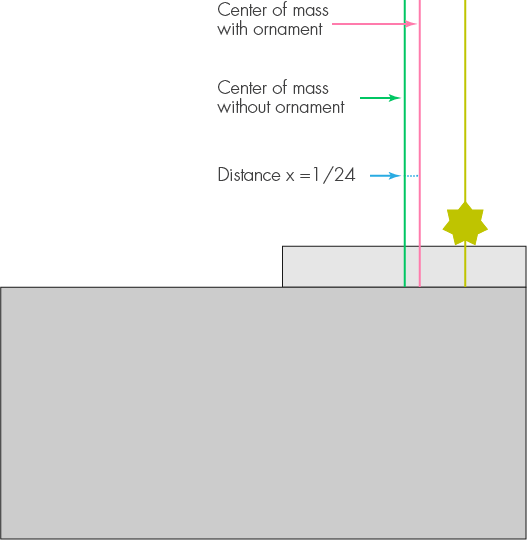
This result and its generalization were obtained by Joerg Fricke (see here and here) and Michael.
Question 3
Imagine that you are competing against your friend in a multi-round game that involves creating overhanging structures. Initially, the two of you are each given a single block. You each have to place your block over an edge of your respective tables, with any amount of overhang you want. Then, you are each given one to four additional blocks, with the number chosen at random. (You both get the same number of additional blocks.) Each round starts with your initial block as the base, without changing its original position, and with a new random set of one to four blocks to add on top. How far over the edge should you place your initial block so that you have the largest possible average overhang over many rounds of this game?
Since each of two to five blocks is equally likely, you have to simply maximize the sum of the highest overhang you can get for these four cases. For a given two- to five-level stack, there is an optimal position of the first block that gives the maximum overhang for that stack. When you plot the best overhang obtainable for each of the four possible stack sizes against a given initial block position, you get two linear and two inverted V-shaped graphs, as described by Joerg Fricke. The apexes of these inverted V’s are located at the optimum initial positions for the original block values for stacks of three or four blocks. You can sum these four graphs to get a graph of the total overhang, which has sharp changes of direction at each of the four optimal positions. It turns out that the best total overhang is at the optimum position for three blocks, after which the graph heads downward. So you should place your initial block assuming you are going to have a total of three blocks — at an overhang of one-sixth of a unit.
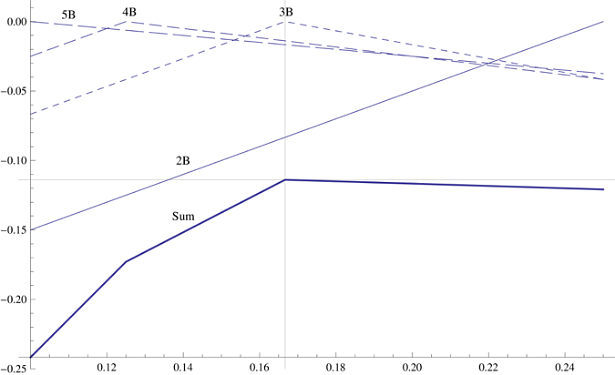
As I mentioned, you can achieve greater maximum overhang for a given number of blocks if you allow multiple blocks per level. As several readers noted, the optimum solutions for this are described in a 2009 paper titled Maximum Overhang, by Paterson, Peres, Thorup, Winker and Zwick. The smaller stacks resulting from this Paterson-Zwick construction resemble kingfishers to my eyes. Larger stacks look like genie lamps. For an overhang of around two units, this procedure is between two to three times as efficient as the classical harmonic overhang, achieving an overhang of two units with 14 blocks instead of 32. Alas, the mathematics is far too complex to consider here!
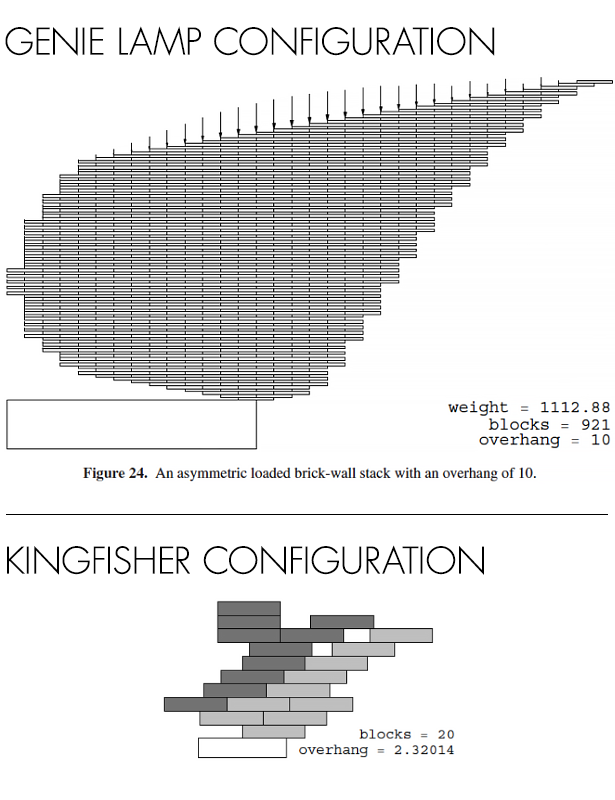
See you next time for new insights.
Correction: Due to a typographical error, the overhang for five blocks was initially published as 1.416…. The column has been revised to reflect the correct overhang distance of 1.1416…



